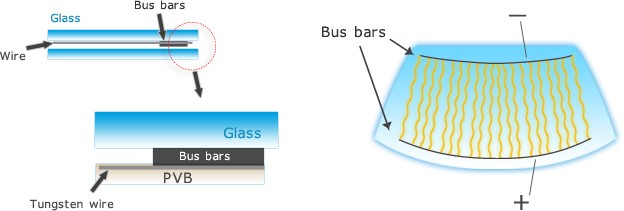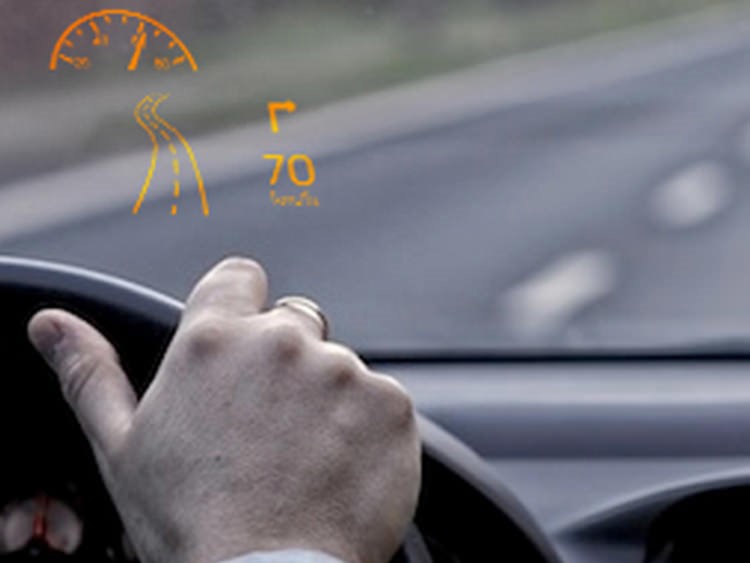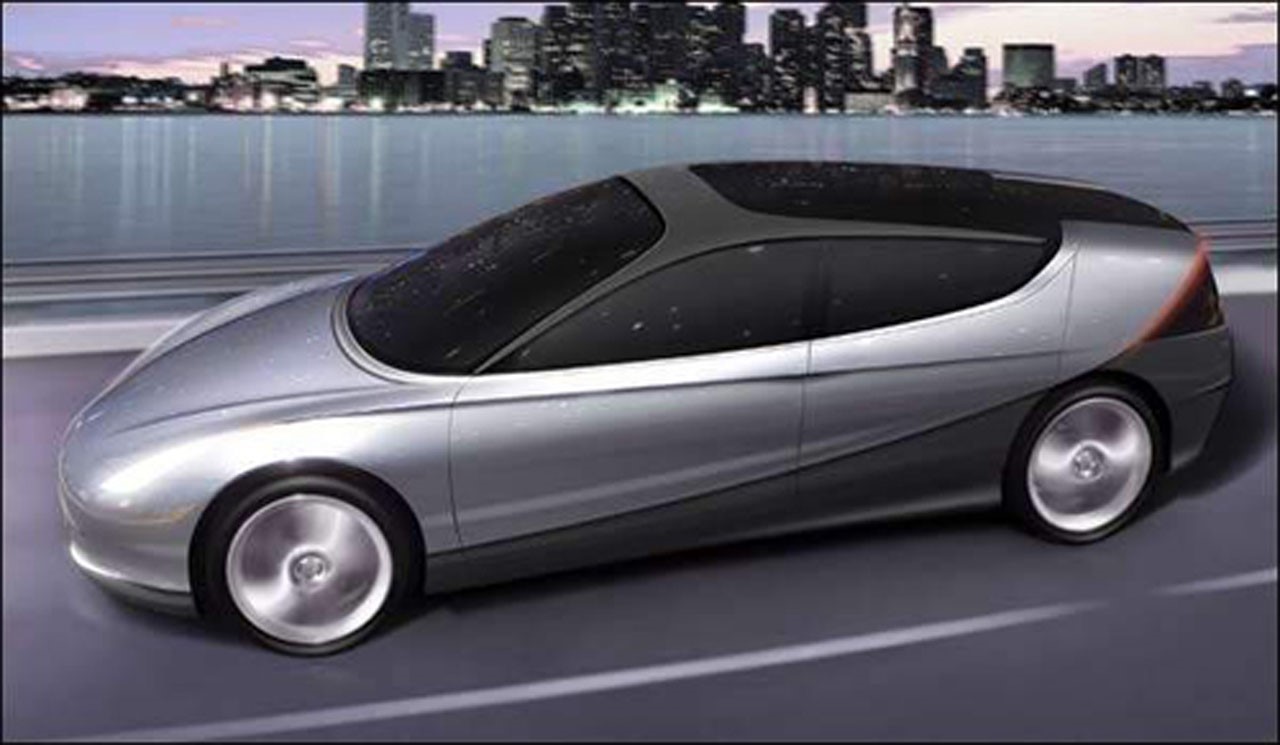Working on automotive smart windshield / window application to tint windows both in automotive mode and manual adjust. It must also be designed to block harmful UV rays and have minimum haze effect (< 5%).
Assume 12v power but looking to go beyond to make it wireless through combination of 1,000 mAh battery and / or supercapacitor combined with energy harvesting technology.
Another possibility might be to combine electrochromic windows and solar cells so that instead of uselessly reflecting away sunlight, darkened smart windows could soak up that energy and store it for later.
There are multiple Smart Glass Technology Innovators in the market – few listed below. Most of them use Electrochromic Technology (Dye or Film) or Nanotechnology:
Pleotint LLC Suntuitive Dynamic Glass.
Gauzy Switchable Glass.
Smart Tint.
MHDT.
EAT Glass.
Solar Control.
Innovative Glass.
Current in market technology is:
1. Electrochromic Technology – Dye or Film.
2. Nanotechnology.
3. Electro Magnetic.
As can note below have investigated current technology options but none provide the groundbreaking technology which can make it a MUST HAVE.
Diamond Coatings for Window Defrosting
The removal of a frost from a windscreen without a heating element can take upwards of 10 minutes waiting for the car engine to warm to blow warm air, another issue is the technology being built into rear view mirrors including rain sensors, speed signs and high beam detectors needing to see clearly through the windscreen to perform.
Heated Windscreens – There is a real possibility with the correct machine type that Diamond Coatings have the technology & expertise to apply coatings to windscreens of vehicles to heat, allowing the removal of ice & demist.
Self-driving vehicles seem to be more certain as the years progress, snow restricts sensors from performing to their full ability. Heaters are possible with specific optical coatings that would perform with the sensor specifications.
Another option with heated windscreens, sensors could be mounted inside the vehicle and specifically an integral part of vehicle interior trim rather than being protected or designed to work in the harsh elements that would exist.
For more information CLICK https://www.diamondcoatings.co.uk/ or write to designhmi@gmail.com.
Heated windshields are made by laying a nearly invisible web of extremely fine tungsten wires within the windshield glass, so you may not be able to tell visibly if you have a heated windshield.
The very thin web of tungsten wire (the same wire used in lightbulbs) layered in the glass are heated up to raise the temperature of the surface of the glass to defrost or melt snow and ice away from the windshield.
While the windshield may not get hot or even warm, it will raise the temperature enough to bring the surface to above freezing so that ice, precipitation, and condensation do not build up, increasing visibility of the road.
Most heated windshield technologies use an electrical element to heat the window, making it easier for your wipers to clear condensation without affecting visibility and leaving streaks on the windshield.
The main benefits of a heated windshield are clearing away ice and condensation away from the windshield, improving visibility. The added benefit of that is not having to run the heaters or air conditioner to defog the windshield, saving gas and reducing noise levels by eliminating the blowers. This helps you in the long run by paying for gas less often, saving you money.
Even if the temperature outside is above freezing, the inside of the windows can fog up. The fog can potentially be as dangerous and obstructive to your view as snow or ice on your windshield. With heated windshield, you can rid the foggy interior of the glass, giving you a clear view to drive shortly after starting the car.
Volkswagen has created a wire-free heated windshield that uses a conductive silver layer in order to heat it, melt the frost and prevent new frost from forming. Instead of using wires, Volkswagen has opted for a thin, transparent layer of silver that provides a conductive layer to heat windshields. It only takes 400-500 watts of energy to help defrost things more quickly. As an extra bonus, filaments are still installed at the bottom section of the windshield to prevent your wiper blades from sticking.
Some car brands, including Mercedes-Benz, Jaguar and Land Rover, have recently released new car models with heated front windshields. A heated front windshield is ideal for Pennsylvania winters because it’s able to defog and defrost faster than standard types.
This special glass works like a heated rear windshield but doesn’t have the black lines that are usually visible. Because a clear field of vision is the biggest concern with windshields, automotive engineers have found a way to make the heating component practically disappear. The Jaguar F-Pace SUV, for example, has a network of thin, translucent wiring sandwiched between two layers of laminate in the windshield. The heating wires inside the glass are only slightly visible, but they don’t inhibit or decrease the driver’s view.
AGC Automotive also offers as an aftermarket wired windshield that defrosts faster than the HVAC System. Click https://www.agc-automotive.com/en/our-products/specific-to-laminated-glass/heated-wire-windshield/ to review.
Another Feature Development for Windshields:
Mercedes-Benz has already taken one small step, eliminating the windshield spray jets on its SL sports car and integrating the windshield fluid delivery system directly into the wiper instead. The German company calls the technology its Magic Vision Control System.
McLaren hopes to go a step further and borrow military technology to do away with the wiper altogether, using ultrasonic sound instead to create a type of ultrasonic force field that prevents anything from sticking to the windshield at all.
The ultrasonic field could be created using something as simple as an ultrasonic transducer in the corner of the windshield, and while initial systems would likely be expensive, if it eventually hits the mass-market the simple, non-moving components could well end up cheaper than mechanical windshield wipers.
All of this could allow the occupants of the car to see clearly out of the windshield without the annoying swish-swish of traditional wipers. Mind you, with autonomous cars likely arriving on our roads in roughly the same time frame, any new wireless technology might be too late to make actual driving any easier, although the autonomous ride would be that much more enjoyable. Something to think about the next time you’re stuck in bumper-to-bumper stop-and-go traffic with the wipers thumping back and forth.
Refer:
https://www.thecarmagazine.com/2014/01/03/mclaren-developing-wiperless-windshield/
GENERIC DESIGN COMMENTS:
An ITO coating can be directly applied to the part itself and Diamond Coatings have formulated a solution which can be applied to smooth, grained, textured, curved and 3D surfaces. This flexibility in coating allows interior lighting designers the freedom in creating a unique lighting design, compared to the limitations put on them by ITO film, which can only be applied to flat surfaces.
With Diamond Coatings ability to deposit coatings directly onto many substrate types and geometries, it gives freedom to automotive interior designers to consider other applications such as arm rest controls, centre console design, sun blind activation and heated cup holders.
Diamond Coatings unique Diamox recipe has been supplied on parts to the automotive industry since 2007, with a score of less than 1 PPM. Such a tight control on quality is testament to the robustness and longevity of applying our ITO coating directly to the part itself, compared to applying it to a film, which adds a considerable amount of failure modes to the process.
For more information CLICK https://www.diamondcoatings.co.uk/ito-coating-vs-ito-film-automotive-interior-capacitive-touch/
Application of Diamond Optical Coatings for Touch Input in Reading Lights, Overhead Console and Other Applications.
Touch Coating is applied directly to the “B” face of the molding with a known contact area using conductive rubber pad or a Conductive Nickel connection area can be added for spring clip connection.
- No Adhesive Interlayer Required which can fail at high operating temperatures.
- No Silver conductive tracks which Oxidize causing sensitivity loss over time.
- Transparent solution for interior lighting allowing the coating to be totally transparent and give the best optical performance for an invisible switch.
- Proven <1 PPM for existing Interior lighting console for leading luxury car manufacturer using this technology.
- Robust coating material performing like a ceramic, base material would fail before the ceramic coating.
DIAMOND COATINGS ITO AND OPTICAL COATINGS
Diamond Coatings is manufacturer of ITO (Indium Tin Oxide) & Optical Coatings to apply coatings on to almost any substrate.
Applications are as below:
- Indium Tin Oxide (ITO) & Anti-reflective (AR) coatings – ITO Glass – RFI Shielding Filters Touchscreens – Capacitive Switches – Microscope Slides & Coverslips – Heater Windows Conductive PET Films – Conductive Tapes – Glass & Plastic Supply – Optional Hard Coatings
The ITO coating design, which is the intellectual propriety right of Diamond Coatings (‘Diamox’).
- Diamox has been specifically engineered to ensure best optical transparency, functional application and to maintain full conductivity for a prolonged use, whilst protecting from any deterioration, degradation or corrosion
- Diamox Product lifetime has exceeded any manufacturer warranty
- Diamox coating complies with current ‘Environmental’ standard requirements
- Diamox coating can be designed to comply with current ‘ESD’ standard requirements through specific design characteristics.
- Automotive – Aerospace, military, medical & other applications.
CAPACITIVE TOUCH ACTIVIATED INTELLIGENT CONSOLE FOR INTERIOR LIGHTING AND OTHER CONTROL FUNCTIONS, UTILISING SUPERIOR TRANSPARENT CONDUCTIVE COATINGS ON PLASTIC.
- In addition to lighting control the console can incorporate features such as: Slider control for sunroof operation.
- Capacitive touch control of further functions.
- Haptic feedback features.
- Single plastic molded console fascia. No requirement for mechanical buttons.
- Capacitive and decorative (anti-reflection) coating options available.
For more information contact below:
DIAMOND COATINGS INC, 4830 S.36th Street, Phoenix, Arizona 85040, Tel: +1 (480) 999 3456
Heated Windscreens – Diamond Coatings
With some countries experiencing weather cold enough to freeze rain or overnight humidity on windscreens, leaving for work at a set time every morning and hoping to arrive on time can be problematic when your windscreen is completely iced over.
Relying on the demist function on most cars results in you sitting and waiting for 10 – 15 minutes for the engine to get warm enough to start de-icing. You can see from the image to the right signs of the warmth getting through after 12 minutes and eventually clearing to see and drive after 18 minutes.
Other technology option of micro sized wires laminated inside the window structure. The downside of this technology is the visibility of the wires, you can see with the image on the left it’s very easy to see the wires, in certain light it can be very distracting.
Diamond Anti Reflection coatings and its ITO coating allowing for large area touchscreens and large area heated products. By applying silver connecting busbars at the outside edge of the glass the ITO will be applied across the entire glass surface creating an invisible electrical circuit which can be warmed to uniformly heat the window surface and defrosting the window in as little as two minutes.
- Two separate heated areas working both sides of the car with a small gap in the center of the screen. Power requirements for these windows are 12v with a resistance of 0.73 Ohms across the wire circuit.
- For the ITO coated version an optical coating thickness allowing for the best optical coating to be applied would require a DC to DC converter to step up the voltage. For safety reasons would be 50v, this would equate to a 12.63 Ohms circuit which would give the optimal heating and coating for the best results.
Diamond Coatings technology allows for various applications such as heating, de-misting or de-icing of windows or headlights. Other related applications can include anti-reflection, glare reduction, display protection and EMC compliance.
For more information on this technology go to www.diamondcoatings.com / www.diamondcoatings.co.uk or write to designhmi@gmail.com















